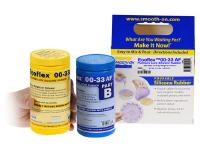Ecoflex™ 00-33 AF /0,91kg
Ecoflex™ 00-33 AF is an anti-fungal silicone rubber that resists the growth of fungi. Parts A and B are mixed 1:1 by weight or volume, pot life is about 45 minutes and rubber cures in about 4 hours at room temperature with negligible shrinkage.
Ecoflex™ 00-33 AF is suitable for making a variety of skin-safe cushioning device configurations that resist fungi for orthopedic and orthotic applications.
Certified Skin Safe - Cured Ecoflex™ 00-33 AF is skin safe and is certified by an independent laboratory. OECD TG 439 certification. No animals were used in testing.
Features
Low viscosity ensures easy mixing and pouring.
Rubber cures without a “tacky” surface, is very soft, very strong with high elongation.
Ecoflex™ 00-33 AF is off-white translucent and can be color pigmented using Silc Pig™ silicone color pigments
Instructions
Safety – Use in a properly ventilated area (“room size” ventilation). Wear safety glasses, long sleeves and rubber gloves to minimize contamination risk. Wear vinyl gloves only. Latex gloves will inhibit the cure of the rubber.
Store and use material at room temperature 23°C. Warmer temperatures will drastically reduce working time and cure time. Storing material at warmer temperatures will also educe the usable shelf life of unused material. These products have a limited shelf life and should be used as soon as possible.
Mixing containers should have straight sides and a flat bottom. Mixing sticks should be flat and stiff with defined edges for scraping the sides and bottom of your mixing container.
Cure Inhibition – Addition-cure silicone rubber may be inhibited by certain contaminants in or on the pattern to be molded resulting in tackiness at the pattern interface or a total lack of cure throughout the rubber. Latex, tin-cure silicone, sulfur clays, certain wood surfaces, newly cast polyester, epoxy, tin cure silicone rubber or urethane rubber may cause inhibition. If compatibility between the rubber and the surface is a concern, a small-scale test is recommended. Apply a small amount of rubber onto a non-critical area of the pattern. Inhibition has occurred if the rubber is gummy or uncured after the recommended cure time has passed.
Because no two applications are quite the same, a small test application todetermine suitability for your project is recommended if performance of this material is in question.
To prevent inhibition, one or more coatings of a clear acrylic lacquer applied to the surface is usually effective. Allow any sealer to thoroughly dry before applying rubber. Note: Even with a sealer, platinum silicones will not work with modeling clays containing heavy amounts of sulfur. Do a small scale test for compatibility before using on your project.
Applying A Release Agent - Although not usually necessary, a release agent will make demolding easier when pouring into or over most surfaces. Ease Release™ 200 is a proven release agent for use with silicone rubber. Mann Ease Release™ products are available from Form X. IMPORTANT: To ensure thorough coverage, lightly brush the release agent with a soft brush over all surfaces of the model. Follow with a light mist coating and let the release agent dry for 30 minutes. If there is any question about the effectiveness of a sealer/release agent combination, a small-scale test should be made on an identical surface for trial.
MEASURING & MIXING... Stir Part A and Part B thoroughly before dispensing. After dispensing required amounts of Parts A and B into mixing container (1A:1B by volume or weight), mix thoroughly for 3 minutes making sure that you scrape the sides and bottom of the mixing container several times. After mixing parts A and B, vacuum degassing is recommended to eliminate any entrapped air. Vacuum material for 2-3 minutes (0,98 Bar), making sure that you leave enough room in container for product volume expansion.
POURING & CURING... For best results, pour your mixture in a single spot at the lowest point of the containment field. Let the rubber seek its level. A uniform flow will help minimize entrapped air.
Curing / Post Curing - Allow rubber to cure as prescribed at room temperature 23°C before demolding. Do not cure rubber where temperature is less than 18°C. Optional: Post curing the mold will aid in quickly attaining maximum physical and performance properties. After curing at room temperature, expose the rubber to 80°C for 2 hours and 100°C for one hour. Allow mold to cool to room temperature before using.
|
|
